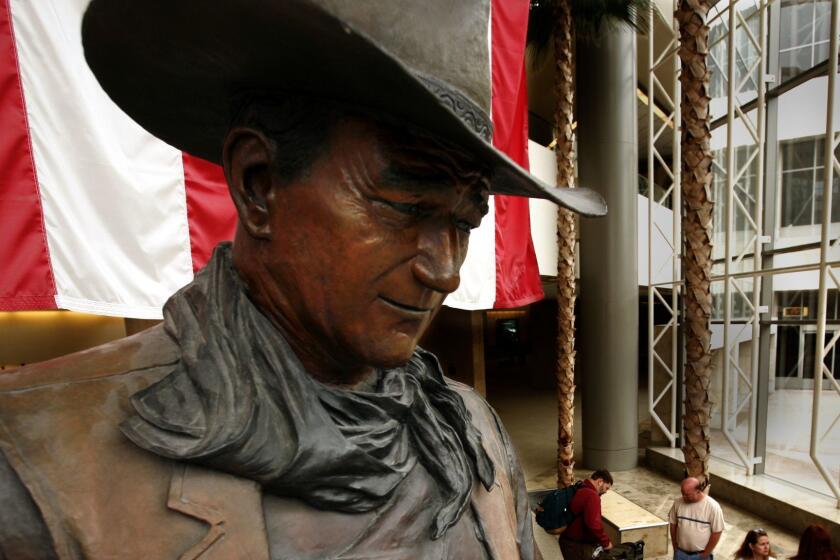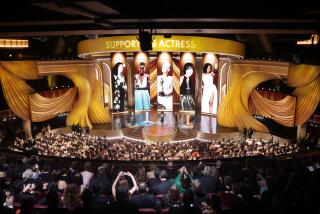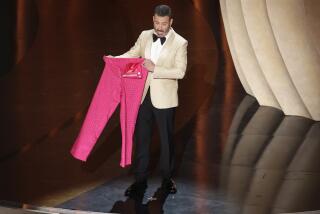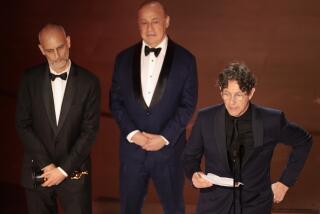Column: Did John Wayne try to assault Sacheen Littlefeather at the 1973 Oscars? Debunking a Hollywood myth
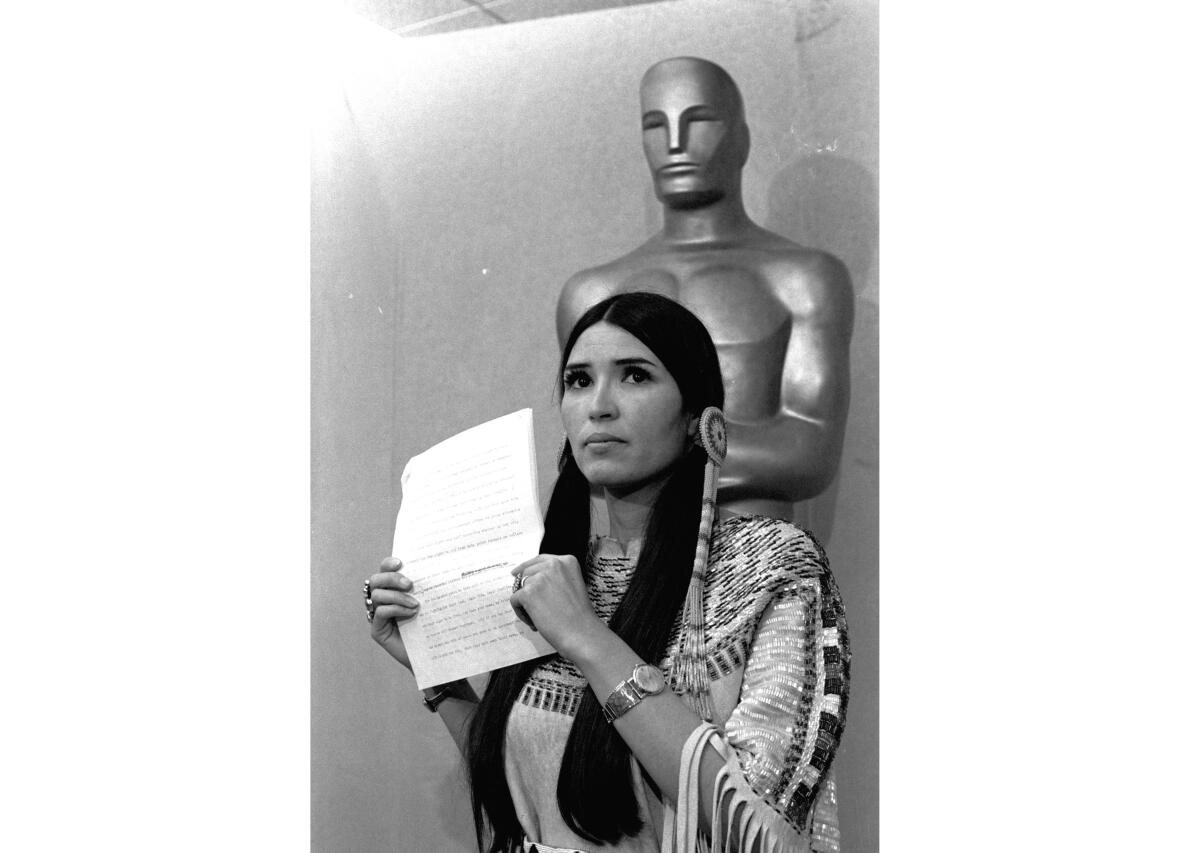
Hollywood loves few things more than retailing myths and legends about itself. Few of these yarns have had a longer life than what happened at the 1973 Academy Awards involving Marlon Brando, John Wayne and a Native American activist named Sacheen Littlefeather.
Movie aficionados generally remember that Brando sent Littlefeather up to the stage to decline his Oscar as best actor for “The Godfather.”
Littlefeather, wearing buckskin and moccasins, read a brief statement of less than a minute, politely stating on Brando’s behalf that he “very regretfully cannot accept this very generous award,” to protest “the treatment of American Indians today by the film industry and on television in movie reruns.”
Once again, we’re flooded with the tale of John Wayne and the Six Security Men, the lousy variety act many people believe played the Dorothy Chandler Pavilion back in 1973.
— Film authority Farran Nehme
She mentioned Wounded Knee, the South Dakota town occupied at that moment by Native activists marking the massacre of 300 Lakota by the U.S. Army at that site in 1890.
Littlefeather was interrupted once by a chorus of catcalls, boos and scattered applause from the audience. She closed with the hope that “in the future, our hearts and our understandings will meet with love and generosity.”
Get the latest from Michael Hiltzik
Commentary on economics and more from a Pulitzer Prize winner.
You may occasionally receive promotional content from the Los Angeles Times.
The whole episode has moved back into the news over the last couple of weeks because the academy last week issued an apology to Littlefeather, now 75, for her reception at the ceremony. The academy also said it would host Littlefeather at an evening of “conversation, healing and celebration” on Sept. 17.
“The abuse you endured because of this statement was unwarranted and unjustified,” the academy apology reads. It may have been alluding to the catcalls from the audience, or perhaps to a crass crack by Clint Eastwood, who, upon presenting the Oscar for best picture, wondered into the microphone whether he should do so “on behalf of all the cowboys shot in John Ford westerns over the years.”
But the part of the story that has grown with the years and was dredged up, again, in articles about the apology is the John Wayne part. According to legend, Wayne, listening to Littlefeather from backstage, became so incensed that he had to be restrained by six security guards from storming the stage to either assault Littlefeather or drag her offstage.
(The legend has also been invoked in reporting of Will Smith’s assault of Chris Rock onstage at this year’s Oscars, generally by people challenging descriptions of that attack as the “ugliest” moment of the Oscars—”What about John Wayne and Sacheen Littlefeather?” goes the typical rebuttal.)
The revival of the Wayne story caught the attention of one of our most learned and entertaining cineastes and film historians, Farran Nehme, who writes an indispensable film blog under the pseudonym Self-Styled Siren.
“Once again,” Nehme writes, “we’re flooded with the tale of John Wayne and the Six Security Men, the lousy variety act many people believe played the Dorothy Chandler Pavilion back in 1973.”
Her conclusion, after considerable reporting and research, is: “Never happened.” Rather, she says, the story began as an exaggerated yarn that Oscar telecast director Marty Pasetta started telling interviewers a year or so after the fact “that got more exciting each time it was told” until it became “a persistent urban legend.”
Nehme’s effort deserves to be acknowledged because it’s a terrific model of how to debunk a story that has been cemented into history. Writers of historical nonfiction have often encountered this problem; I know I have. In researching almost every one of my own books, I’ve found myself trying to track down a cherished historical “fact” and discovering that it has absolutely no basis in reality. It’s a chore that almost counts as an occupational hazard.
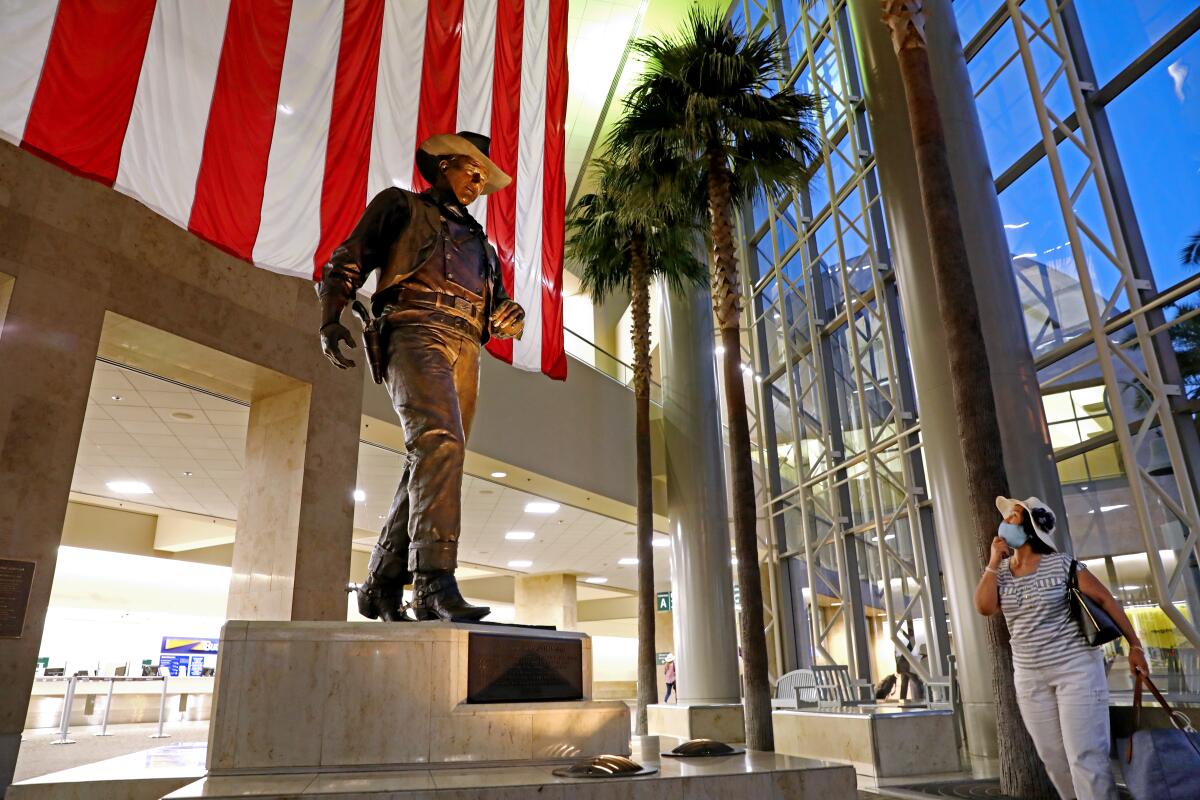
In this case, Nehme has to deal not only with Pasetta’s version but also one offered by Littlefeather herself on several occasions, including in a 2020 documentary about herself. There, as Nehme reports, she states, “I was escorted off of that stage by some armed guards.... And luckily so because John Wayne was waiting in the wings ready to go on to pull me off the stage, and he had to be held back by six security men because he was so outraged about what I had said.”
Nehme starts her inquiry by noting the evolution of Pasetta’s own story. In 1974, he told an interviewer that on hearing Littlefeather speak, “John Wayne [is] backstage and he’s in an uproar and I had to calm him down.” In 1984, he told another interviewer that “John Wayne was in the wings and was so angry he wanted to go and pull her offstage.”
The six security men (a suspiciously precise number, Nehme observes) first make their appearance in 1988, when he told a third interviewer, “We had a fight is what we had.... John Wayne wanted to go out there and physically yank her off the stage. It took six men to hold him back.”
Then there’s the circumstantial evidence. When Littlefeather took the stage, no one knew what she would say — including Howard Koch, the Oscars producer, who had merely told her she would have 60 seconds to speak and then the stage would be darkened and she would be escorted off.
Most people familiar with the life story of John Wayne are aware that the late movie star was a dyed-in-the-wool right-winger — after all, he was still making a movie glorifying America’s conduct of the Vietnam War (“The Green Berets,” 1968) well after the country had begun to get sick of the conflict.
A clip of her appearance shows that she actually appeared on stage for about one minute and 20 seconds. She spends the first half-minute or so introducing herself as an Apache and the president of the Native American Affirmative Image Committee. Only then does she say that Brando is declining the award and why. Then she demurely follows the presenters, Roger Moore and Liv Ullman, offstage.
As Nehme observes, that would suggest that in the space of 45 seconds, John Wayne heard her words, decided that they were infuriating, got up to mount an attack, and drew the resistance of six security guards.
It’s worth keeping in mind, as she points out, that nine years earlier Wayne had undergone lung cancer surgery in which two of his ribs and part of his left lung were removed. He was never entirely hale and hearty after that. Indeed, at the closing set piece of the telecast, when Wayne arrives onstage to invite all the winners to come out for a wan mass rendition of “You Oughta Be in Pictures,” he’s noticeably gasping for breath.
Wayne never criticized Littlefeather personally; his general comment when asked about Brando’s refusal is that the actor should have come out and done it in person.
Littlefeather suffered years of ridicule, which the academy alludes to in its apology. But she conducted herself with poise and calm; after her stage appearance she was brought by Moore to the Oscars press room, where she read out the long statement Brando had written.
And of course, Brando was right to be critical of Hollywood’s treatment of Native Americans, then and now. The academy has been trying to make amends, in its way. Among other efforts, it created an Indigenous Alliance whose co-chair, producer Bird Runningwater, will conduct the conversation with her next month. Native Americans have benefited from a slow evolution of inclusiveness in American movies in recent years, but much more needs to be done to erase its stereotypical treatment of the past.
As for the John Wayne story, it’s an insult both to the academy and to Wayne himself. We’ve been critical in the past of the tendency to accept Wayne’s on-screen persona of a rough-and-tough American frontiersman, including, yes, as an Indian-killer, as true to life — notably in the naming of Orange County’s airport for him and the installation of a big statue of the Hollywood version of Wayne in front of its terminal.
Wayne was a dyed-in-the-wool political conservative, but according to his biographer, Scott Eyman, in real life he was a “well brought up Edwardian man” who would never think of assaulting a woman. Nehme elicited that insight from Eyman directly, noting that he didn’t even mention the episode in his book about Wayne.
“Nobody I talked to who knew Wayne,” Eyman told her, “ever referred to or, apparently, believed that story.” It would be justice to retire it forever.
More to Read
Get the latest from Michael Hiltzik
Commentary on economics and more from a Pulitzer Prize winner.
You may occasionally receive promotional content from the Los Angeles Times.

